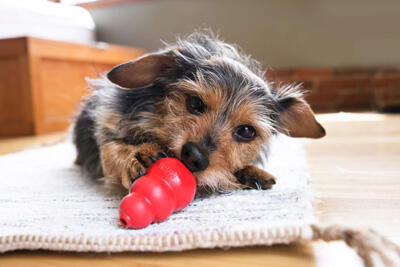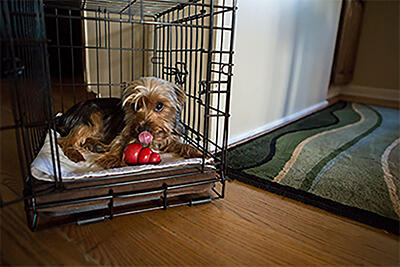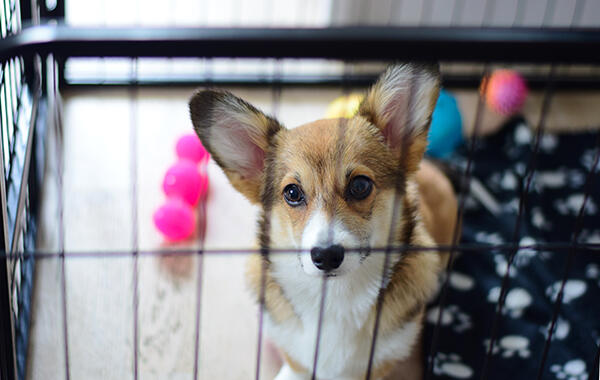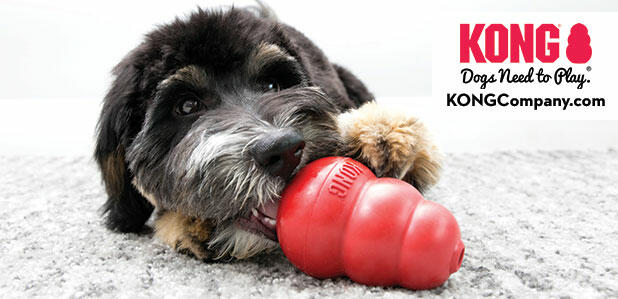Help clients teach their dogs that crate time means fun time
By Kong Company Staff
As pet professionals, owners look to you for tools they can use on their own to help enhance their dogs’ lives at home. For example, crate training can help with several of the top issues owners struggle with: housebreaking, safe travel, keeping dogs out of mischief when left alone and separation anxiety.
Relationship Building
As you know, the key to successful crate training is helping dogs create a positive association with being inside it. Giving them a food-stuffed toy, such as a Kong, helps satisfy instinctive need to chew while providing enriching mental and physical stimulation.
 If your clients are not yet familiar with the toy-stuffing strategies, they could use their dog’s favorite treats to create a long-lasting interactive puzzle. To start, they can loosely stuff the toy with small pieces of a high-value food that will easily fall out as the dog plays. They could also seal the toy’s opening with dog-safe peanut butter or a squirt of Kong Easy Treat to keep the treats inside and to entice dogs to play. Owners could also make the toy more challenging and time consuming by stuffing it with a mixture of wet and dry food. The variety of textures keeps things interesting, as each bite is differently delicious. It helps to alternate wet and dry in layers. For the ultimate challenge, owners could freeze the stuffed toy for 3 to 5 hours before giving it to their dog.
If your clients are not yet familiar with the toy-stuffing strategies, they could use their dog’s favorite treats to create a long-lasting interactive puzzle. To start, they can loosely stuff the toy with small pieces of a high-value food that will easily fall out as the dog plays. They could also seal the toy’s opening with dog-safe peanut butter or a squirt of Kong Easy Treat to keep the treats inside and to entice dogs to play. Owners could also make the toy more challenging and time consuming by stuffing it with a mixture of wet and dry food. The variety of textures keeps things interesting, as each bite is differently delicious. It helps to alternate wet and dry in layers. For the ultimate challenge, owners could freeze the stuffed toy for 3 to 5 hours before giving it to their dog.
Before introducing their dog to her crate, they should show her the stuffed toy, letting her sniff it to ensure she know it is filled with goodies. Next, they should place the toy in the back of the crate. As the dog enters the crate and settles into a tasty chewing session, they should keep the door open. Letting their dog enjoy a treat-filled toy inside a comfortable den, helps build a positive association with the crate.
 Have your clients repeat this a few times until their dog does not hesitate to go into the crate. Once she happily settles into the crate, her owners can practice closing the door and leaving the area for a short time. Be sure to remind them to not make a big deal of their departure or return to the crate area to avoid creating anxiety.
Have your clients repeat this a few times until their dog does not hesitate to go into the crate. Once she happily settles into the crate, her owners can practice closing the door and leaving the area for a short time. Be sure to remind them to not make a big deal of their departure or return to the crate area to avoid creating anxiety.
Owners can gradually increase the amount of time they spend out of sight while their dog is in her crate. Once she can spend about half an hour in the crate, her owners can begin to leave home for short periods. Gradually, they can increase the time spent away.
Remind your clients to always leave the crate out so that their dog can retreat to her “den” on her own to relax in a quiet, comfy spot. This also helps dogs develop a positive relationship with their crate. While food-stuffed Kong toys help build a positive relationship in a dog’s mind between her crate and happy chewing, it also helps develop the positive relationship between the owner and you. Giving owners a variety of tools and strategies, they can use on their own helps cement their trust in your expertise—and make their lives with their dogs even better.






